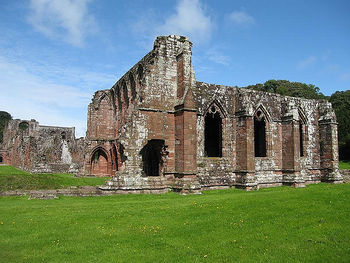Furness Abbey
Furness Abbey was established in the early 12th century as a community of Savigniac monks. In 1147 the abbey come into the possession of the Cistercian order of monks when they absorbed the Savigniacs. By the 13th century Furness Abbey controlled estates which made its Abbot one of the most important land owners in the Furness area.
History
Furness was originally home to a community of Savigniac monks. Count Stephen of Boulogne (later King of England) invited them in 1124 to create a monastery in Lancashire. They first established themselves at Tulketh, but this was short lived and in 1127 they abandoned the site and moved to establish Furness Abbey. In 1147 the Savigniac order of monks was subsumed by the Cistercians. The abbot of Furness initially opposed the merger but eventually accepted it.[1] The community at Furness Abbey spawned several daughter monasteries. In 1134 the abbeys of Calder and Rushen were both founded by monks from Furness. More abbeys subservient to Furness were founded in 1180 (Inch in Ireland) and in 1205 (Abington).[2]
In the early 14th century war broke out between Scotland and England. The abbey’s location in northern England made it a target for Scottish raids, and in 1316 the Furness peninsula was sacked by the Scots. They ventured this far south in 1322, but this time the area was spared as the Abbott paid Robert the Bruce to leave Furness unharmed.[3]
Amongst the properties held were the abbey were several castles including one which was actually built by the abbey on Piel Island.[3] The castle was first mentioned in 1327 when the abbey was granted a licence to crenellate a building they owned on Piel Island. It is uncertain why the castle was built, though in the early 14th century northern England was subjected to Scottish raids and the fortification may have offered a degree of protection to the monastic community.[4] The abbot petitioned King Edward III for the licence, writing "The Abbot of Furness asks that, for his salvation and that of his monks and the country against the Scots, that he might have permission to enclose a messuage called Fowdray in Furness, and to fortify and crenellate it".[5][6]
Furness Abbey was dissolved in 1537, and afterwards the castle was recorded as in a poor state of repair and its condition gradually decayed over the following centuries.[7] Furness Abbey is both a Grade I listed building and a scheduled monument. The ruins are now under the care of English Heritage and are open to the public.[8]
References
- ↑ Wood, Jason (2011). “History of the Abbey” in Furness Abbey. London: English Heritage. p. 23. ISBN 978-1-85074-674-4.
- ↑ Wood, “History of the Abbey”, p. 25.
- ↑ 3.0 3.1 Wood, “History of the Abbey”, p. 27.
- ↑ Newman, Rachel (2011). “Piel Castle” in Furness Abbey. London: English Heritage. p. 37. ISBN 978-1-85074-674-4.
- ↑ Piel Castle licence to crenellate, Gatehouse Gazetteer. Accessed 17 January 2013.
- ↑ Davis, Philip (2006–7). "English Licences to Crenellate 1199–1567", The Castle Studies Group Journal vol 20. p. 238.
- ↑ Newman, “Piel Castle”, p. 38.
- ↑ “Furness Abbey, including all medieval remains in care of English Heritage”, Heritage Gateway. Accessed 28 February 2013.
